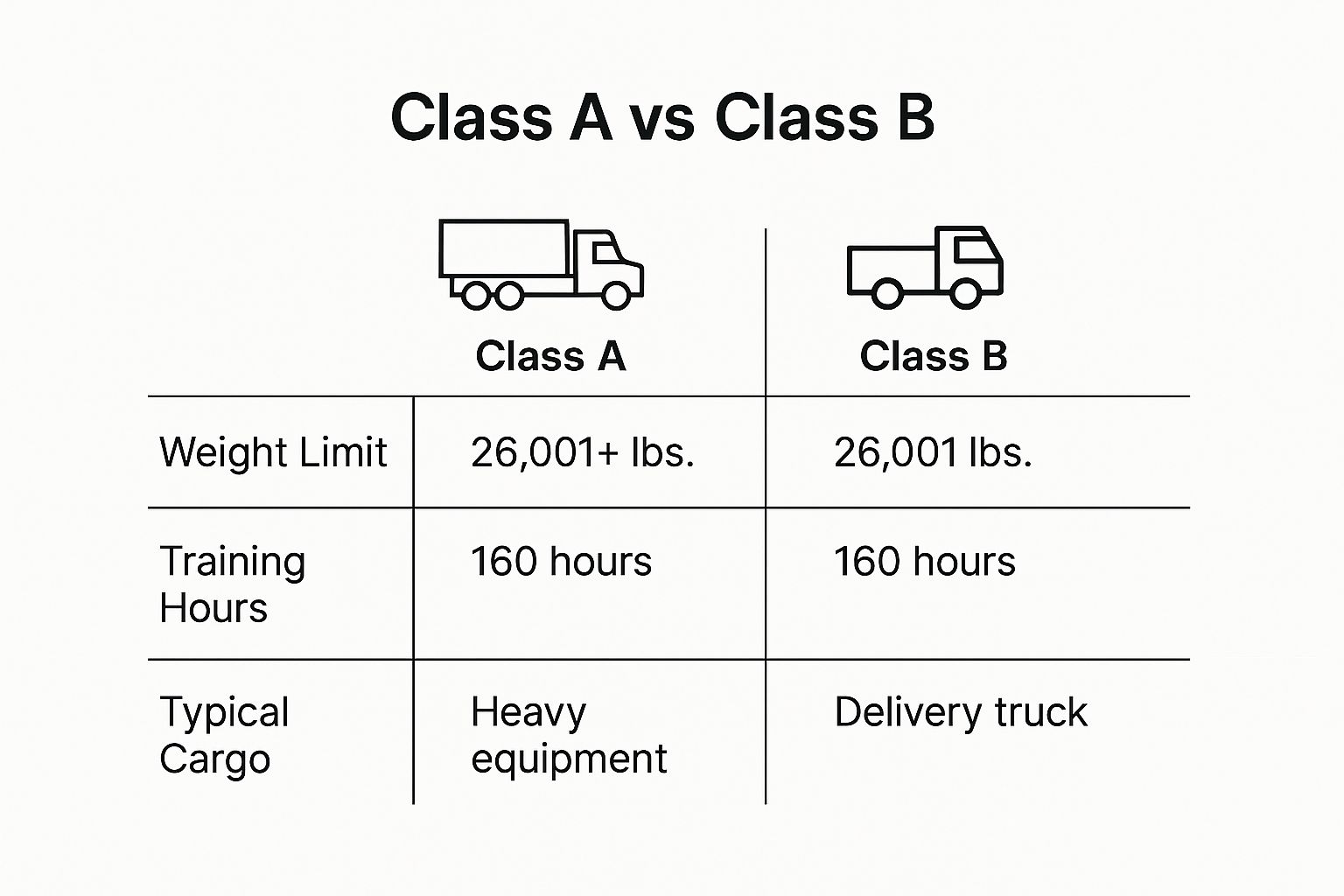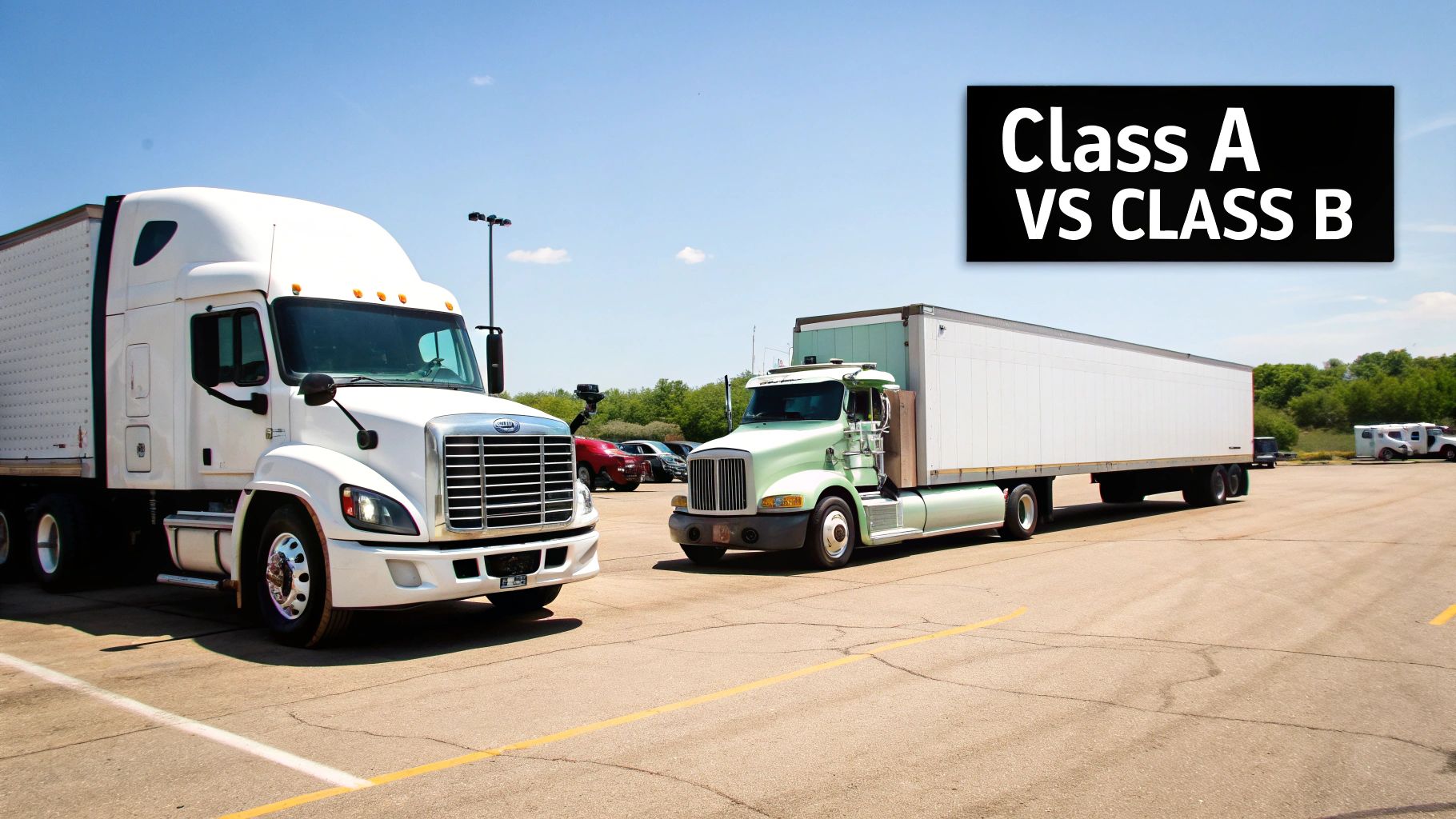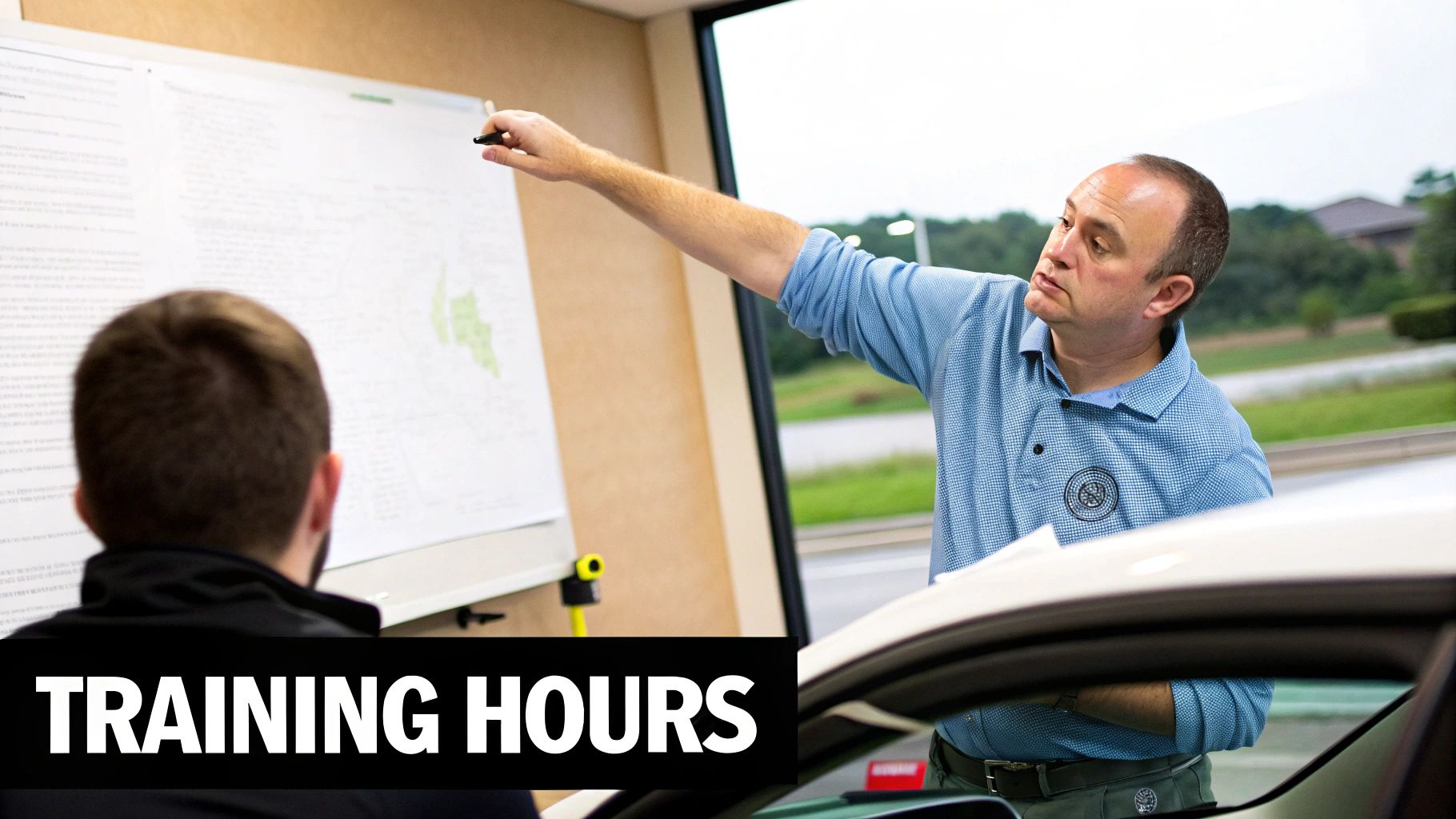When you're trying to decide between a CDL Class A and a Class B license, what it really boils down to is vehicle type and career path. A Class A license is the key to driving the big rigs—tractor-trailers with a trailer over 10,000 pounds—which usually means higher-paying, over-the-road jobs.
On the other hand, a Class B license sets you up to drive heavy single vehicles like dump trucks, school buses, or box trucks. This path is perfect if you're looking for local or regional work that gets you home more often.
Understanding the Core Differences
Picking between a Class A and Class B CDL is one of the first and most important decisions you'll make in your trucking career. Both licenses get you on the road professionally, but they lead to completely different work environments, daily schedules, and paychecks. The biggest difference is the kind of vehicle—and how much it weighs—that you're legally allowed to drive.
The main functional split is in the vehicle configurations. A CDL Class A lets you operate combination vehicles with a Gross Combination Weight Rating (GCWR) of 26,001 pounds or more, as long as the trailer you're hauling is heavier than 10,000 pounds. Think of it as the top-tier license; it gives you the most options.
In simple terms, a Class A license is your all-access pass in the trucking world. With it, you can legally operate most Class B and Class C vehicles, making you a more versatile and in-demand driver.
A Visual Comparison of Each License
This chart breaks down the fundamental differences in weight limits, training hours, and common cargo for each license.

As you can see, the Class A license doesn't just cover heavier and more complex vehicle setups; it also generally demands more in-depth training to master.
CDL Class A vs Class B At a Glance
To really simplify things, here’s a quick table that lays out the major distinctions between the two license classes. Getting these details straight is crucial before you even think about your permit exam. If you want to know what to expect on that test, our guide to the general knowledge test is a great place to start.
| Feature | CDL Class A | CDL Class B |
|---|---|---|
| Vehicle Type | Combination vehicles (tractor-trailers) | Single vehicles (straight trucks, buses) |
| Gross Weight Rating | 26,001+ lbs (vehicle + trailer) | 26,001+ lbs (single vehicle) |
| Towing Capacity | Can tow trailers over 10,000 lbs | Limited to trailers under 10,000 lbs |
| Typical Career Path | Long-haul (OTR), regional, freight | Local delivery, construction, public transport |
| Earning Potential | Generally higher due to cargo and distance | Strong, but often with a lower ceiling |
This table gives you a solid, high-level view. While both paths lead to great careers, the Class A opens up a wider range of opportunities, especially for those interested in long-haul freight and maximizing their income.
Comparing the Vehicles You Can Drive

The biggest difference between a Class A and Class B CDL boils down to one simple thing: the rig you're sitting in. This isn't just about sheer size, though. It’s about the vehicle's design and what it takes to control it safely. One license puts you behind the wheel of a combination vehicle, while the other is for large, single-frame trucks.
A Class A license is your ticket to driving the kings of the road, particularly the classic tractor-trailer. These are articulated vehicles—meaning the cab and trailer are separate units connected by a pivot point. That setup demands some serious skill, especially when you’re backing up or navigating a tight turn.
This license also unlocks the potential to operate other massive combination vehicles that are the backbone of our economy.
Typical Class A Vehicles
With a Class A, you could find yourself hauling all sorts of specialized freight. Each rig has its own personality and requires unique know-how to handle it safely.
- Tractor-Trailers: These are the iconic 18-wheelers you see on the highway, hauling everything from refrigerated food to dry goods across the country.
- Tanker Trucks: When you're moving liquids like gasoline, milk, or chemicals, you're dealing with a shifting cargo load. It's a whole different ballgame.
- Flatbed Trucks: Got oversized or weirdly shaped cargo? Flatbeds are the answer for moving heavy machinery, construction materials, and massive pipes.
Typical Class B Vehicles
A Class B license, on the other hand, gives you the authority to operate heavy single-unit vehicles. The key difference is that these trucks don’t have a separate, detachable trailer weighing more than 10,000 pounds. They are built on a single chassis, which completely changes how they handle.
Think of the day-to-day life of a Class B driver: navigating a delivery truck through congested city streets or maneuvering a dump truck on a busy construction site. The challenges are more about tight spaces and frequent stops than endless miles of open highway. It’s an ideal path for drivers who want to stay closer to home with more predictable schedules.
The core difference is the pivot. Class A is all about managing that articulation point between the tractor and trailer. Class B is about mastering a single, rigid vehicle.
No matter which license you hold, knowing your truck inside and out is non-negotiable. It's your responsibility to understand every system and component, which is why a thorough pre-trip inspection is a fundamental skill every single commercial driver must master.
Here are some of the workhorses you can drive with a Class B CDL:
- Straight Trucks: You probably know them as box trucks. They’re everywhere, handling local deliveries of furniture, appliances, and packages.
- Dump Trucks: These are essential for any construction or public works project, hauling gravel, sand, asphalt, and other materials.
- City and School Buses: With the proper endorsements, a Class B license is what you need to transport passengers around town or get kids to school safely.
- Cement Mixers: A highly specialized truck that’s critical for delivering ready-mix concrete right where it's needed on a job site.
Analyzing Career Paths and Earning Potential

The license you choose—Class A or Class B—is one of the biggest factors that will shape your career, your daily life, and what you see on your paycheck. Both licenses unlock the door to great, in-demand jobs, but they send you down very different highways.
The real question you need to ask yourself is this: are you chasing the highest possible income, even if it means long stretches away from home? Or is a predictable, local route with more home time your top priority?
The Class A Driver: High Earnings on the Open Road
A Class A license is your ticket to the highest earning potential in the entire trucking industry. It’s what you need for over-the-road (OTR), regional, and dedicated freight hauling careers. OTR drivers are the backbone of the American supply chain, moving goods across the country and often spending weeks at a time on the road.
Now, that lifestyle isn't for everyone, but the financial rewards can be significant. A seasoned Class A driver, especially one holding valuable endorsements like hazmat, can easily push their income into the upper brackets. It's a straightforward trade-off: you give up time at home for a much higher salary ceiling.
The Class B Driver: Stability and Work-Life Balance
On the flip side, a Class B license usually leads to local or regional jobs that come with a far more consistent schedule. These roles are absolutely vital for keeping our communities and local economies running smoothly. We're talking about city bus drivers, dump truck operators on construction sites, and the local delivery drivers who keep businesses stocked.
The biggest draw for a Class B career is the work-life balance. Most of these jobs are standard day shifts, which means you're home every night. While the average salary for a Class B driver is typically lower than what a Class A driver makes, that stability and predictability are exactly what many professionals are looking for.
When you boil down the CDL Class A vs Class B debate, it really comes down to lifestyle. Class A promises freedom and high income, but it costs you time at home. Class B offers routine and a connection to your community, with a more modest—but still very solid—earning potential.
Career Opportunities and Salary Comparison
To give you a clearer picture, it helps to see the roles and salary expectations side-by-side. Remember, things like your location, years of experience, and any endorsements you have will play a big role in the final numbers.
| Career Aspect | CDL Class A | CDL Class B |
|---|---|---|
| Common Job Titles | OTR Truck Driver, Regional Driver, Tanker Hauler, Flatbed Operator | Delivery Driver, Dump Truck Operator, Bus Driver, Concrete Mixer |
| Typical Schedule | Weeks on the road, irregular hours, long-haul routes | Daily routes, predictable 8-10 hour shifts, home every night |
| Earning Ceiling | Higher, often exceeding $80,000+ with experience and endorsements | Solid and stable, typically ranging from $45,000 to $65,000 annually |
| Career Growth | Opportunities to become an owner-operator or fleet manager | Advancement to supervisory roles in local logistics or public works |
In the end, the right career path is the one that fits what you value most. If you're ready to embrace the trucking lifestyle to maximize your income, the Class A license is the obvious way to go.
But if you’re looking for a dependable career that lets you stay close to home, the Class B license offers some excellent, stable opportunities. Digging into a comprehensive CDL training program is a great next step to figure out which path truly aligns with your personal and financial goals.
A Look at the Training and Licensing Process
Getting your Commercial Driver's License isn't just about passing a test. It's about getting the right kind of training for the specific truck you plan to drive. While both Class A and Class B licenses fall under the federal Entry-Level Driver Training (ELDT) rules, the programs themselves are worlds apart, each designed for a very different set of on-the-road challenges.
The training for a Class A CDL is, without a doubt, the more demanding of the two. Since you’ll be handling a combination vehicle, a huge chunk of your time is spent learning how the tractor and trailer work together—or sometimes, don't work together. This means getting really good at tricky maneuvers like coupling and uncoupling, as well as mastering various backing techniques like alley docking a massive articulated rig.
On the other hand, Class B training is all about safely managing one large, single vehicle. The curriculum is built around skills like performing detailed inspections on a straight truck or bus, handling the wide turning radius in city traffic, and safely navigating the constant stop-and-go of urban routes.
The Time and Cost Investment
A major factor in the cdl class a vs class b debate is what you'll need to invest in time and money. Because of the extra complexity, Class A training is almost always longer and more expensive. A solid Class A program can easily take several weeks to finish, with costs often climbing into the thousands.
Class B programs tend to be shorter and more affordable. Since you don't have to learn the ins and outs of articulated vehicles, you can often get your license faster. This makes it a quicker path into the industry if you're aiming for a local driving job.
The real difference in training boils down to the pivot point. Class A is all about mastering the dynamics of a tractor-trailer, while Class B is focused on controlling the sheer weight and size of a single-frame truck.
Comparing the Curriculum and Skills
To pick the right path, you need to know exactly what each training program focuses on. Seeing the differences side-by-side makes it clear which one lines up with the kind of driving you’ll be doing every day.
-
Class A Training Focus:
- Coupling and Uncoupling: Learning the precise steps to safely connect and disconnect a tractor from different trailers.
- Advanced Backing: Getting confident with tough maneuvers like straight-line, offset, and alley dock backing.
- Space Management: Understanding how to handle the long stopping distances and wide turns that come with a 53-foot trailer.
-
Class B Training Focus:
- Vehicle Inspections: Running through detailed pre-trip checks specifically for vehicles like straight trucks, dump trucks, or buses.
- Urban Driving Skills: Navigating tight city corners, managing heavy traffic, and handling frequent stops without incident.
- Weight Distribution: Knowing how to properly load cargo in a single-unit truck to keep it stable and safe.
Of course, before you can even start training, you have to meet the basic qualifications. For a full rundown, you can learn more about the specific CDL requirements you’ll need to meet to get started.
How Endorsements Shape Your Trucking Career

Getting your CDL is the starting line, not the finish. If you really want to open doors to the best-paying, most specialized jobs in trucking, you’ll need to add endorsements to your license. Think of them as special certifications that prove you can handle specific kinds of cargo or vehicles.
The endorsements you go after should line up perfectly with the license you have and the career you want. For any driver weighing CDL Class A vs Class B options, this isn't a small decision. One license path leads toward hauling complex freight cross-country, while the other is all about essential local and regional transportation roles.
Strategic Endorsements for Class A Drivers
If you're a Class A driver, a few key endorsements are pretty much non-negotiable if you want to maximize your income and have real flexibility. These are the endorsements that let you haul the most valuable and in-demand freight out there.
- H (Hazardous Materials): This one is a total game-changer. It gives you the green light to transport things like chemicals, fuel, and other regulated materials. You’ll have to pass a thorough background check, but the pay bump is almost always worth it.
- N (Tank Vehicle): This is a must-have for hauling bulk liquids like gasoline or milk, and it often goes hand-in-hand with the H endorsement. Liquid cargo shifts around, so it takes a specific skillset to handle it safely.
- T (Double/Triple Trailers): With this endorsement, you can pull two or three trailers at once, which is common out West and for specific carriers like LTL companies. Your ability to haul more freight means you earn more.
A Class A driver holding the "triple threat" of H, N, and T endorsements is one of the most capable and sought-after professionals on the road. This combination unlocks just about every high-paying, long-haul gig the industry has to offer.
Key Endorsements for Class B Drivers
While Class A drivers are often focused on hauling freight, Class B drivers usually build careers around moving people or handling specialized local jobs. It makes sense, then, that their endorsement strategy looks a little different.
- P (Passenger): This endorsement is absolutely required to operate any vehicle designed to carry 16 or more passengers, including yourself. It's your ticket to a career driving city buses, tour buses, or airport shuttles.
- S (School Bus): This is a specialized version of the P endorsement with even tougher requirements, including another in-depth background check. It qualifies you for one of the most stable and respected driving jobs in any community.
And here’s a pro tip for any new driver: if you test in an automatic but want to keep your options open for manual trucks down the road, an e restriction removal course is a smart move. It gives you the skills you need without forcing you to retest completely.
Choosing the right endorsements from day one makes you a far more skilled and marketable driver, no matter which license class you choose.
Making the Right Choice for Your Trucking Career
Deciding between a CDL Class A and a Class B license isn't just a career move—it's a choice that shapes your entire lifestyle. The right answer really comes down to what you want out of your life, both on and off the clock. You have to get honest with yourself about your priorities, your financial goals, and what you imagine your day-to-day looking like.
Are you chasing the biggest paychecks and the freedom of the open road? If that’s you, the Class A license is almost certainly your best bet. It’s the key that unlocks the highest-paying over-the-road (OTR) and regional jobs, but it comes with a trade-off: you’ll be spending a good amount of time away from home.
Or, is being home every night a deal-breaker? In that case, the Class B license is designed for exactly that. It’s your ticket to local work in delivery, construction, or public transit. While the earning potential might not be as high, the work-life balance is a huge plus for anyone who wants to stay connected to their community and family.
Scenario-Based Guidance
Let's walk through a couple of real-world scenarios. Thinking about the cdl class a vs class b question through the lens of different career goals can make the right path much clearer.
-
The Future Owner-Operator: If your long-term plan is to own your own rig and run your own trucking business, you'll need a Class A license. No question. It gives you the flexibility to haul the widest range of freight, which means more business opportunities and a higher ceiling for growth.
-
The Career Changer Prioritizing Stability: For someone looking for a steady job with a predictable schedule, a Class B license is a fantastic choice. You can build a great career as a city bus driver or a local delivery specialist and never have to worry about missing family dinners or weekend events.
At the end of the day, the right license is the one that builds the life you actually want to live. Don't just look at the starting pay; think about your long-term happiness and what will keep you satisfied in your career for years to come.
Before you sign up for a single class, picture your ideal workday. Do you see yourself cruising down the interstate, crossing state lines with a full load? Or are you more comfortable navigating familiar city streets, becoming a regular face in your local area? Answering that one simple question will point you toward the license that will launch—and sustain—your career.
Your Top CDL Questions, Answered
When you're weighing the pros and cons of a CDL Class A vs. Class B, a lot of questions come up. It's totally normal. Getting straight answers is key to making a choice you feel good about, so let's tackle some of the most common ones we hear from new drivers.
Can I Drive a Class B Truck with a Class A License?
Absolutely. Think of the Class A license as the top of the pyramid. Once you have it, you're legally qualified to operate any vehicle that falls into the Class B or Class C categories.
Of course, you'll still need the right endorsements for specialized vehicles (like a school bus or tanker), but the core qualification is already there. This built-in flexibility is one of the biggest draws of going for the Class A right out of the gate.
What's Involved in Upgrading from a Class B to a Class A?
Making the jump from a Class B to a Class A isn't just about taking another test. You'll need to go through a certified Entry-Level Driver Training (ELDT) program specifically designed for the Class A.
The process involves getting a new Commercial Learner's Permit (CLP) for the upgrade and then passing the full Class A skills and road tests. The new training zeroes in on everything you didn't cover for your Class B, with a heavy focus on operating combination vehicles.
The biggest learning curve when upgrading is mastering the skills unique to Class A rigs. This means getting comfortable with coupling and uncoupling trailers and nailing complex backing maneuvers with an articulated vehicle—it's a whole different ballgame.
Which CDL Test Is Harder?
There's no sugarcoating it: the Class A CDL test is widely considered more difficult than the Class B. The skills test, in particular, is a much bigger challenge because it requires you to prove you can safely handle a combination vehicle.
Maneuvers like alley docking a full tractor-trailer are worlds away from what's expected for a single-unit truck. On top of that, the pre-trip inspection for a Class A vehicle is far more detailed. You're responsible for inspecting the coupling system and the entire trailer, which means more parts to know and more things that need to be checked perfectly.
Ready to start your journey on the open road? At Patriot CDL, we provide expert, hands-on training to get you licensed and career-ready in as little as three weeks. Learn more about our CDL programs.
